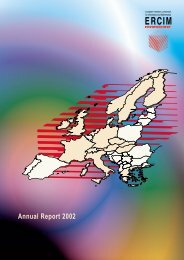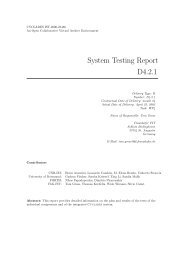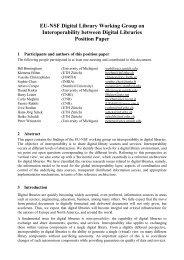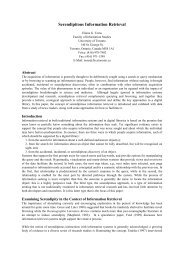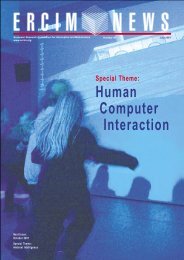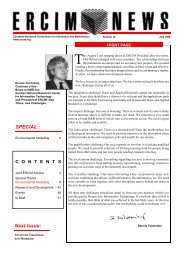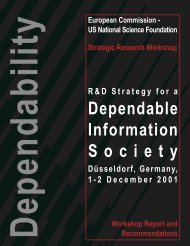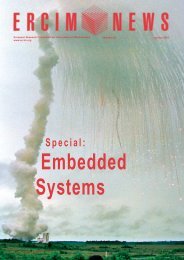Towards a Platform for Widespread Embedded Intelligence - ERCIM
Towards a Platform for Widespread Embedded Intelligence - ERCIM
Towards a Platform for Widespread Embedded Intelligence - ERCIM
You also want an ePaper? Increase the reach of your titles
YUMPU automatically turns print PDFs into web optimized ePapers that Google loves.
Figure 1: The Pondcaster interactive artefact<br />
and some mobile devices.<br />
aspects of radio listening from the early<br />
days of radio. The tabletop artefact<br />
builds on devices that can be found in<br />
every listener's pocket, such as media<br />
players and possibly mobile phones, and<br />
features unencumbered interaction via a<br />
touch screen.<br />
The tabletop artefact acts as a sink <strong>for</strong> the<br />
podcast content of the users' media<br />
players, providing a snapshot of their<br />
current choices and podcast tastes. On<br />
physical connection, the content of any<br />
media player is automatically shown,<br />
using an animated aquatic metaphor. The<br />
pond shows groups of similar content as<br />
animated shoals of creatures, where each<br />
creature represents a podcast show. To<br />
avoid clutter, the metaphor is selfcleaning,<br />
whereby old, unused shoals<br />
slowly sink to the bottom of the virtual<br />
pond. By interacting with the creatures<br />
representing podcast shows, users can<br />
access show details and start listening,<br />
which favours collaboration and discovery<br />
of new sources. The artefact is<br />
also linked to a phone number and any<br />
user can send an SMS containing the<br />
words of a query. On reception, acting as<br />
an internet podcast search engine, the<br />
artefact will display matching podcast<br />
shows as a new shoal. These shows are<br />
typically not present on any connected<br />
R&D AND TECHNOLOGY TRANSFER<br />
Figure 2: Upon interaction, creatures representing shows surface and the artefact<br />
starts playing their content.<br />
media player, which again favours discovery<br />
of new shows. Finally, the artefact<br />
keeps track of bluetooth-enabled<br />
mobile phones in its close vicinity. Users<br />
can express their intention to listen further<br />
to newly discovered shows by dragging<br />
specific creatures to a representation<br />
of their phone.<br />
Figure 3: Two users listening to podcast<br />
shows at one listening station. The TV<br />
screen shows the waiting list (some users<br />
off-picture) and sound comes from the<br />
directed speaker hanging from the roof.<br />
The associations between shows and<br />
mobile phones will be remembered by<br />
the system. At a later time, users are able<br />
to listen to the chosen shows at public<br />
radio-like terminals. Users within the<br />
bluetooth vicinity of such a terminal will<br />
be recognised and their selections<br />
retrieved and played using a queue<br />
system. The setting encourages socialising,<br />
discussion and mobility since it<br />
keeps track of listening state across a set<br />
of listening stations <strong>for</strong> a given user.<br />
The Pondcaster is based on existing<br />
internet technologies and because the<br />
system uses bluetooth tagging, no data is<br />
ever moved to mobile phones and media<br />
players. Subscriptions and preferences<br />
are kept on the Pondcaster and made<br />
available <strong>for</strong> further access by media<br />
players and Web browsers. As such, the<br />
artefact <strong>for</strong>ms the premises of a personalised<br />
podcast aggregator.<br />
Link:<br />
http://www.sics.se/ice/projects/pondcaster<br />
Please contact:<br />
Emmanuel Frécon, SICS, Sweden<br />
Tel: +46 8 6331500<br />
E-mail: emmanuel@sics.se<br />
<strong>ERCIM</strong> News No. 67, October 2006<br />
65



